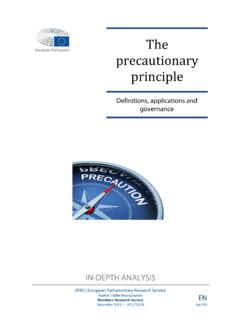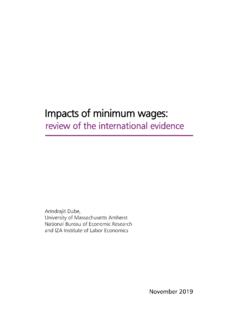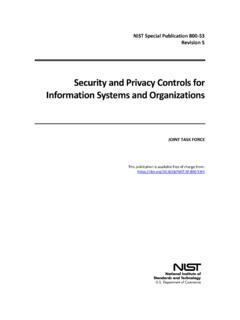Transcription of SAFE WATER FOR THE COMMUNITY
1 SAFE WATER FOR THE COMMUNITY A Guide for Establishing a COMMUNITY -Based Safe WATER System Program Edition 1 January 2008 Acknowledgments Written by: Daniele S. Lantagne, PE Centers for Disease Control and Prevention William Gallo, PhD Jolivert Safe WATER for Families Program The following individuals provided valuable assistance in the form of original material or critical review: Eric Mintz, MD, MPH Robert Quick, MD, MPH Centers for Disease Control and Prevention Michael Ritter Emory University Genevieve Brin Massachusetts Institute of Technology Dr. Robert Johnson Missions of Love Introduction An estimated billion people worldwide do not have access to an improved WATER supply, and many more drink unsafe, contaminated WATER from improved sources. Each year, inadequate access to safe drinking WATER and improper sanitation cause an estimated 4 billion cases of diarrhea and million deaths in developing countries, mostly among young children.
2 In addition, waterborne diarrheal diseases lead to decreased food intake and nutrient absorption, malnutrition, reduced resistance to infection, and impaired physical growth and cognitive development. Factors contributing to this high rate of diarrheal disease incidence include: poor sanitation, poor hand hygiene, contaminated WATER , and lack of sufficient household WATER . Programs that provide latrines, education about soap and washing hands, access to microbiologically clean WATER , and/or enough WATER all help reduce the incidence of diarrheal disease. The CDC Safe WATER System Program The Safe WATER System (SWS) program is a household WATER treatment intervention developed by the Centers for Disease Control and Prevention (CDC) and the Pan American Health Organization (PAHO) in response to the cholera epidemics that swept across Latin America in the early 1990s. The Safe WATER System consists of three elements: WATER treatment with hypochlorite solution in the home; Storage of WATER in a safe container; and, Education and behavior change communications to improve hygiene and WATER handling practices.
3 CDC, in conjunction with partner organizations such as the United States Agency for International Development, Population Services International, and CARE, has established SWS programs in over 30 countries around the world. In addition, CDC has completed a substantial amount of research on the effectiveness of the Safe WATER System, and written a handbook that describes how to start an SWS program. The handbook, Safe WATER Systems for the Developing World: A Handbook for 3 Implementing Household-Based WATER Treatment and Safe Storage Programs, provides a comprehensive guide to treat household WATER with a hypochlorite olution. The handbook is oriented towards large-scale or national programs. Free opies of the handbook in English, Spanish, French, or Arabic may be obtained by mailing PDF versions of the handbook in English, Spanish, nd French are included on the accompanying CD. urpose of this Guide ecently, many organizations have expressed an interest in establishing COMMUNITY -ased SWS programs on a smaller scale.
4 This guide complements the SWS andbook by providing specific, detailed information to assist organizations to evelop COMMUNITY -based SWS programs. eveloping a COMMUNITY -Based SWS Program his guide is organized into seven key steps that are necessary to plan and mplement a COMMUNITY -based SWS program. The first step is to assess the ommunity s need for an SWS program, and the feasibility of implementing the rogram. The second step is to organize the staff necessary to carry out the rogram. Management of the pilot project is discussed in Steps 3 through 6, from roduct selection and development of educational materials through implementation nd evaluation. The final step is to learn from the experiences of the pilot project ow to best expand the program throughout the COMMUNITY and beyond. Step 1: Complete Need and Feasibility Assessment .. 6 Step 2: Organize the SWS Program and Select 12 Step 3: Select the SWS Products.
5 17 Step 4: Develop Strategy and Materials for User and COMMUNITY Education .. 42 Step 5: Establish a Pilot Project in the 48 Step 6: Evaluate the Pilot Project .. 52 Step 7: Develop a Plan for Moving Forward .. 55 sceaPRbHdDTicpppah 4 Supporting Information The experiences of the Safe WATER for Families program in Jolivert, Haiti, are used throughout this guide to illustrate the development of one successful COMMUNITY -based program. An CD that contains supporting information necessary to develop a COMMUNITY -based program accompanies this guide. Information on the CD that is referenced throughout this guide can be found by opening the files, organized by step, on the CD. The CD also includes an Excel Spreadsheet for budgeting. The Safe WATER System is an effective, proven intervention that reduces diarrheal disease incidence and is easy for families to use. Please feel free to contact us at if you have any questions or would like a copy of the SWS handbook.
6 You can also visit our website at for more information. An SWS User in Madagascar CDC is a branch of the federal government and does not endorse products from specific companies. Information provided herein is for reference purposes only to describe the Jolivert program experience, and does not represent the full range of available products. 5 Step 1: Complete Need and Feasibility Assessment The first step in starting an SWS program is to assess the feasibility of the program based on three factors: 1) the needs and desires of the COMMUNITY ; 2) existing WATER resources; and, 3) the capacity of your organization to implement a program. Collecting Information in the COMMUNITY Information on WATER practices in the COMMUNITY , health knowledge in the COMMUNITY , and resources available in the COMMUNITY is needed before beginning a program. Potential sources for this information include existing reports, medical records at clinics or hospitals, on-site visits to households and institutions in the COMMUNITY , and conversations with COMMUNITY leaders, government officials, and non-governmental organizations (NGOs).
7 Quantitative information can be obtained through a survey of COMMUNITY members. Sample surveys are included on the accompanying CD. Before developing an SWS program as detailed in subsequent steps, answers to the following sets of questions are needed. Answers to this first set of questions about the COMMUNITY will help determine the potential size and scope of the program: How many people or families are in the COMMUNITY ? How many families have one or more children under-5 years old? How dispersed are the houses in the COMMUNITY ? Answers to the following questions on WATER resources and WATER storage will help determine the SWS products that will be needed in the program, including the safe storage container and the hypochlorite solution: What sources of WATER do people in the COMMUNITY use? o Is there sufficient WATER at each of these sources? o Do these sources always have WATER ? o Is WATER from these sources turbid (full of solids/dirty looking)?
8 6 What containers do people use to collect WATER and store WATER in the home? o How many liters do these containers hold? o Are they open (like buckets without a lid) or closed (like a jerry can)? o What materials are they made of (ceramic, plastic, metal)? Answers to these questions on COMMUNITY knowledge of disease will help you develop educational materials: How frequently do children have diarrhea (defined as 3 or more loose stools per day)? o Does diarrhea vary by season? Do people perceive diarrhea as a problem in the COMMUNITY ? Do people understand that diarrhea is an illness that can be transmitted via contaminated WATER ? Do people use latrines? Do people know to wash hands at critical times, including before preparing or eating food, after changing a baby, and after toileting? Is soap available for washing hands? Answers to these last questions are important for program logistics: What material resources are in the COMMUNITY for the program?
9 O Is there space to store equipment? o Is there electricity? What human resources are in the COMMUNITY ? o Are there trustworthy, respected personnel in the COMMUNITY who are capable of working with the program? Is there financial support for the program and ongoing financial planning? Assessing the WATER Resources in a COMMUNITY The SWS is most applicable where families have enough WATER for their daily needs. If a COMMUNITY does not have enough WATER , a WATER source intervention, such as the installation of a well, construction of WATER storage cisterns, or improvements to a 7 spring, may be more effective at reducing diarrhea than an SWS program. Such an intervention may also be more acceptable to the COMMUNITY . Studies have shown that access to enough WATER (for drinking, bathing, cooking, and cleaning) is linked to a reduction in diarrheal disease. Even if there is a reliable source of WATER for a COMMUNITY , WATER can become contaminated during collection, transport, and storage in the home.
10 The Safe WATER System addresses this issue, by treating WATER after collection and transport. It can be assumed that all untreated WATER in developing countries is contaminated at the source or becomes contaminated during handling at the household level. Therefore WATER quality testing before beginning an SWS program is not needed, although it can be completed if desired. Sometimes a COMMUNITY has sufficient WATER , but it may be turbid, meaning cloudy or dirty-looking with solid particles in it. When this is the case, some kind of treatment is preferred before the hypochlorite solution is added. The turbidity can be removed by allowing the dirt to settle to the bottom of the container and then pouring off the clean WATER ; filtering the WATER through a cloth; or using a natural flocculant; such as raket, which is a type of cactus that grows in Haiti, alum, a common mineral in Africa, Collecting Turbid WATER in Ethiopia or moringa seeds.













